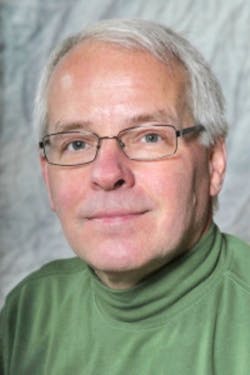EDI CON keynoter Cameron of ADI looks at getting to 5G
Boston, MA. “5G five years from now—how do we get there?” was the title of a keynote presentation at EDI CON USA 2017 by Thomas Cameron, CTO of the communications business unit at Analog Devices Inc. “Wireless is all about connectivity,” he said. “In the wireless world, the most terrifying words are ‘no service.’ You need connectivity to Uber, to Google. As connectivity improves, the challenge is to get connectivity to point to where we don’t even think about it.”
If the rollout of 5G represents the point at which we no longer need to be thinking about 5G, that could represent a lot of people not thinking about it. Cameron cited the Ericsson Mobility Report, June 2017, as predicting 500 million 5G subscribers by 2022.
Cameron offered an overview of 5G, saying key aspects include high performance, low latency, high device density, long battery life, high energy efficiency, and high reliability. It will offer broadband everywhere (eMBB, or enhanced mobile broadband), massive connectivity (mMTC, or massive machine-type connectivity), and mission-critical support (uRLLC, or ultra-reliable low-latency communications). 5G, he added, will enable new business models that we haven’t thought of yet. A key feature 5G is the flexibility to enable new use cases and new markets.
From a technical perspective, he said 5G NR is expected to be deployed in new spectrum, with the NR waveform similar to LTE CP-OFDM. Beamforming will be prevalent above 2 GHz.
Sub-6-GHz 5G implementations will be characterized by massive MIMO, digital beamforming, high radio count (64t64r), and an evolution from current BTS technology. Benefits such as spectral-efficiency improvement have been demonstrated, and sub-6-GHz 5G offers the possibility of compatibility with existing UEs. Challenges to be addressed relate to size, weight, power consumption, cost, complex antenna interfaces, and fronthaul issues. Areas for innovation include filter size and weight (through materials, design, and algorithms), power-amplifier efficiency (through GaN processes, Doherty circuitry, and digital predistortion, or DPD), and radio size and power (through architecture, integration, algorithms, and platforms). He foresees heterogeneous integration with CMOS and other process technologies. “We have brought CMOS to bear on radio,” he said.
Moving beyond 6 GHz up into the mmWave bands, Cameron said he anticipates very high antenna count with hybrid beamforming. Benefits at mmWave frequencies include utilizing the large available spectrum to deliver high data rates. Challenges relate channel models, fading, beam acquisition and tracking, power consumption, and cost.
Cameron noted that much work related to OTA testing and calibration remains to be done. But he predicted that in the future connectivity will be “…as accessible as air—something you just don’t think about.”
Cameron’s plenary address paved the way for many technical presentations and exhibits throughout the week that could be applicable to 5G. Several presentations were 5G-specific:
- “Massive MIMO and ‘beamforming’: The signal processing behind the 5G buzzwords,” by Claire Masterson, a systems applications engineer in the communication systems team at Analog Devices;
- “Simulation of BER, EVM, and ACPR Performance Under Proposed 5G Modulation Waveforms,” by David Vye, National Instruments/AWR, and Andy Hughes, NI AWR Group,
- “3 Critical Considerations for 5G Wireless Network Antennas,” by Ray Butler, vice president of wireless network engineering at CommScope; and
- “MIMO and Beam Steering Modeling in Support of 5G Applications,” by John Dunn at NI.
Many of these presentations and supporting papers are available on the EDI CON USA website as I post this. Click on Check Out the Technical Program.
By the way, in trying to arrange a meeting with Cameron after his keynote presentation, I got the dreaded “no service” message. An industrious member of ADI’s press-relations team managed to track me down on foot.
About the Author

Rick Nelson
Contributing Editor
Rick is currently Contributing Technical Editor. He was Executive Editor for EE in 2011-2018. Previously he served on several publications, including EDN and Vision Systems Design, and has received awards for signed editorials from the American Society of Business Publication Editors. He began as a design engineer at General Electric and Litton Industries and earned a BSEE degree from Penn State.
